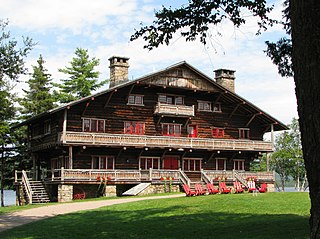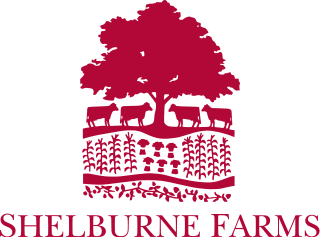
Great Camp Sagamore is one of several historic Great Camps located in the Adirondack Mountains of northern New York State.

Charles A. Lindbergh State Park is a 569-acre (2.3 km2) Minnesota state park on the outskirts of Little Falls. The park was once the farm of Congressman Charles August Lindbergh and his son Charles Lindbergh, the famous aviator. Their restored 1906 house and two other farm buildings are within the park boundaries. The house, a National Historic Landmark, and an adjacent museum are operated by the Minnesota Historical Society, known as the Charles Lindbergh House and Museum. Three buildings and three structures built by the Works Progress Administration in the 1930s were named to the National Register of Historic Places. These buildings include a picnic shelter and a water tower, built in the Rustic Style from local stone and logs, and have remained relatively unchanged since construction. Although the property includes shoreline on the Mississippi River, the Lindbergh family requested that the park not include intensive use areas for swimming or camping, so development was kept to a minimum.

Shelburne Farms is a nonprofit education center for sustainability, 1,400 acres (570 ha) working farm, and National Historic Landmark on the shores of Lake Champlain in Shelburne, Vermont. The property is nationally significant as a well-preserved example of a Gilded Age "ornamental farm", developed in the late 19th century with architecture by Robert Henderson Robertson and landscaping by Frederick Law Olmsted.

This list includes properties and districts listed on the National Register of Historic Places in Moore County, North Carolina. Click the "Map of all coordinates" link to the right to view an online map of all properties and districts with latitude and longitude coordinates in the table below.
This is a list of the National Register of Historic Places listings in Williamson County, Tennessee.

Greenmead Historical Park, also known as Greenmead Farms, is a 3.2-acre (1.3 ha) historic park located at 38125 Base Line Rd., Livonia, Michigan. It includes the 1841 Greek Revival Simmons House, six other structures contributing to the historic nature of the property, and additional buildings moved from other locations. Greenmead Farms was designated a Michigan State Historic Site in 1971 and listed on the National Register of Historic Places in 1972.
Smithson–McCall Farm is a 256.3-acre (103.7 ha) historic district in Bethesda, Tennessee. The farm was listed under the National Register of Historic Places in 2007. The listing claims that the property "documents the impact of the progressive agricultural movement of the early twentieth century on the operations and landscape of a middle-class family farm," and includes an "architecturally significant group of buildings and structures, placed within an agricultural landscape of high integrity...that represents a good example of farmstead architecture in Middle Tennessee and that reflects the impact of the Progressive Farm movement of the early twentieth century".
Bethesda, Tennessee is an unincorporated community in rural southeastern Williamson County, Tennessee.

Red Maple Farm, also known as Gulick House, is a historic house and bed and breakfast located on Raymond Road west of the Monmouth Junction section of South Brunswick in Middlesex County, New Jersey. It was added to the National Register of Historic Places on July 3, 1979, for its significance in agriculture and architecture. In addition to the main house, a smoke house and barn contribute to the property.

Harlinsdale Farm is a 198-acre (80 ha) historic district in Franklin, Tennessee that was listed on the National Register of Historic Places in 2006. It dates from c.1900 and had other significant dates in 1935 and 1945.

The Dimond Hill Farm is a historic farm at 314 Hopkinton Road in the western rural section of Concord, New Hampshire. Established on land that was first farmed by Ezekiel Dimond in the mid-18th century, this area has been farmed by the members of the Abbott-Presby family since 1827, and is one of the few remaining working farms in the city. The main house is an 1892 rambling structure that connects the family living space with the large barn, which dates to c. 1882. The oldest structure on the farm is a corn crib from the 1850s. The farm was listed on the National Register of Historic Places in 2007. The owners operate a farm stand on a seasonal basis.

The Buckminster-Kingsbury Farm is a historic farmhouse at 80 Houghton Ledge Road in Roxbury, New Hampshire. The brick house was built c. 1825, and is a well-preserved example of vernacular Federal and Greek Revival styling. The house was listed on the National Register of Historic Places in 2011.

The James Gowing Farm, also once known as Staghead Farm, is a historic farmstead on Page Road in Dublin, New Hampshire. It is now the centerpiece of the Dublin Christian Academy campus. The original 1+1⁄2-story Cape style house was built c. 1788 by James Gowing, Jr., not long after moving to the area. This structure is now part of a larger complex of buildings, many of which are Colonial Revival buildings built in the 1930s, when the house was also restored. The farmstead was listed on the National Register of Historic Places in 1983.

The Moore Farm and Twitchell Mill Site is a historic property on Page Road in Dublin, New Hampshire. The 6.8-acre (2.8 ha) property includes an early 19th-century farmhouse, as well as the remnants of one of Dublin's earliest industrial sites. It lies just south of a bend in Page Road in southern Dublin, where Stanley Brook runs east-west along the south side of the road. In c. 1768 Samuel Twitchell, Dublin's second settler, built a sawmill that used Stanley Brook as its power source. This mill was the second established in what is now Dublin, after that of Eli Morse. It was used until the mid-19th century, and now only its foundations remain. The farmhouse of Samuel Moore was built in a glen on the south side of the brook c. 1812, and was a vernacular Cape style farmhouse. The farm was purchased in 1935 by William and Katherine Mitchell Jackson, and the house was moved about 100 yards (91 m) to the top of a rise where it has commanding views of Mount Monadnock. The house was restored and enlarged under the guidance of architects Bradley & Church and again renovated in 1951. The farm complex includes a barn that is contemporaneous to the house, and a caretaker's cottage that is a 1952 reconstruction of an earlier one destroyed by fire.

The Oliver Whiting Homestead is a historic farmstead on Old County Farm Road in Wilton, New Hampshire, just south of the County Farm Bridge. The 72-acre (29 ha) property was one of the region's largest dairy farms in the early 19th century, and it was used as Hillsborough County's poor farm between 1867 and 1896. The main focus of the property is a large Federal-style brick house built c. 1800 by Oliver Whiting; it also has an 1846 Gothic Revival barn which predates the establishment of the poor farm. The property was listed on the National Register of Historic Places in 1982.
The Dan Johnson Farmstead is a historic farm property on United States Route 2 in Williston, Vermont. It was first developed in 1787 by Dan Johnson, one of Williston's first settlers, and has remained in his family since that time. The property includes three 19th-century houses and a large barn complex, as well as more than 200 acres (81 ha) of land crossed by US 2 and Interstate 89. It was listed on the National Register of Historic Places in 1993.

The Murray–Isham Farm, or more recently just the Isham Family Farm, is a historic farm property at 3515 Oak Hill Road in Williston, Vermont. The farm has been in active use since about 1850, most of them by the Isham family. The farmstead includes a c. 1850 Gothic Revival house and farm buildings of similar vintage. It was listed on the National Register of Historic Places in 1992, and is the subject of a conservation easement preserving its agricultural character.
The Shook-Vanzant Farm, also known as the Moore Farm, is a historic farmhouse near Winchester, Tennessee, U.S.. It was built in 1893 for Nathan Shook. The property includes several other buildings, including two houses, several barns, and a garage. It was later acquired by the Vanzant family, whose descendants are the Moore family.

Scamman Farm is a historic farmstead at Portsmouth Avenue in Stratham, New Hampshire. The farm was established by members of the Scamman family in the 1660s, and includes a barn dating to the mid-18th century, believed to be one of the oldest in the state, and a Greek Revival farmhouse dating to 1836. The property, now a subset of the family's original holdings, was listed on the National Register of Historic Places in 2019.















